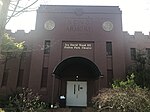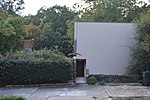North Carolina State University Memorial Belltower
1937 establishments in North CarolinaBell towers in the United StatesBuildings and structures in Raleigh, North CarolinaBuildings and structures in Wake County, North CarolinaCarillons ... and 6 more
Clock towers in North CarolinaNorth Carolina State UniversityStone buildings in the United StatesTourist attractions in Raleigh, North CarolinaTowers in North CarolinaWorld War I memorials in the United States

The North Carolina State University Memorial Belltower (officially the Memorial Tower, informally known as the Belltower) is a 115-foot-tall (35 m) free-standing bell tower on the Main Campus of North Carolina State University in Raleigh, North Carolina Conceived as a war memorial to honor university alumni killed in World War I and the university's overall participation in the conflict, the Belltower now serves as a perpetual memorial for N.C. State students and alumni who gave their lives in the service of the nation. A prominent university symbol, the tower is a popular rallying point for the campus community.
Excerpt from the Wikipedia article North Carolina State University Memorial Belltower (License: CC BY-SA 3.0, Authors, Images).North Carolina State University Memorial Belltower
Founders Drive, Raleigh Oberlin
Geographical coordinates (GPS) Address Nearby Places Show on map
Geographical coordinates (GPS)
| Latitude | Longitude |
|---|---|
| N 35.78615 ° | E -78.66351 ° |
Address
Memorial Belltower
Founders Drive
27695 Raleigh, Oberlin
North Carolina, United States
Open on Google Maps









